Design of the Month · April 2014
-
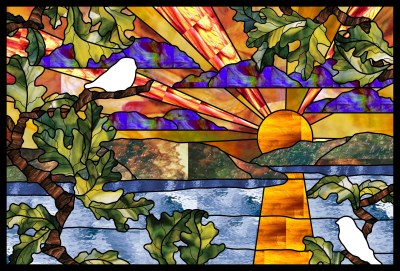
"Sunset and Goldfinches"
The "Sunset with Goldfinch" project started as a request from a client who had worked with me several years ago. I had created a smaller "Blackbird and Cattail" design for her farmhouse property,
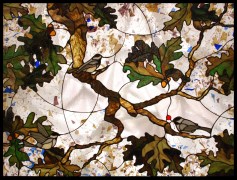
 and seeing her over the years at my art fairs we had talked on and off about another project for her city home in Madison, WI.
Eventually the time was right and we started to discuss the specifics the project.
What was wanted was a "beautiful scene" not unlike my work I show at my art fairs which consist of lots of natural colors but populated with leaf clusters, branches and birds.
The challenge on this project was to incorporate a sunset background, a departure from the regular approach on my panels
which typically have a background of clear and fracture streamer glasses of various sorts.
and seeing her over the years at my art fairs we had talked on and off about another project for her city home in Madison, WI.
Eventually the time was right and we started to discuss the specifics the project.
What was wanted was a "beautiful scene" not unlike my work I show at my art fairs which consist of lots of natural colors but populated with leaf clusters, branches and birds.
The challenge on this project was to incorporate a sunset background, a departure from the regular approach on my panels
which typically have a background of clear and fracture streamer glasses of various sorts.The project begins with an idea and some very quick thumbnail sketches. These are done on scraps of paper, or more often than not these days on an iPad. Once I get a rough idea I move directly to Glass Eye 2000. I use Glass Eye 2000 on an iMac via Parallels and interface using a Wacom Intuos Pro 5 Touch. This allows me to draw lines more naturally and gives me the ability to switch between functions very quickly using the customizable hot keys on the side. I lay out the basic outline using a JPEG of my sketch imported as a background and sketch over the design to get my basic layout. Then I remove the background and refine, refine, refine. I do multiple revisions of any given project that are either based on different ideas I have or based on client suggestions or changes. Glass Eye 2000 is great for the ability to make these changes quickly and to save all revisions.
Once the drawing is done in Glass Eye 2000, I export it as a JPEG and bring it into either Photoshop or SketchBook Pro. Then I draw in the areas that will be hand painted. This will give me a fantastic effect for client presentation. This is the shown to my client with pricing, and once approved I am good to go.
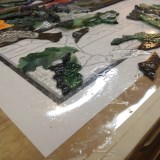 I print two full-size patterns on a 24" HP printer, so I have minimal tiling to do. I use one as a full size cartoon,
I print two full-size patterns on a 24" HP printer, so I have minimal tiling to do. I use one as a full size cartoon,
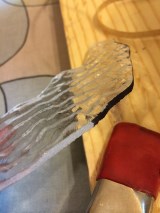 and the other I cut with a regular scissors.
I trace and cut normally, occasionally using a ring saw. Shaping is done with two grinders, each with different size bits with different coarseness.
I place the pattern under a large sheet of clear waterproof Graphix film so I can place my wet glass pieces directly upon the surface without ruining the pattern paper.
One shaping is done, I wash, clean and dry my parts. Any pieces that are clear I will take a black magic marker on the edge to prevent any silver-ish cast when viewed from an angle
(even black back foil doesn't fully prevent this undesirable effect).
and the other I cut with a regular scissors.
I trace and cut normally, occasionally using a ring saw. Shaping is done with two grinders, each with different size bits with different coarseness.
I place the pattern under a large sheet of clear waterproof Graphix film so I can place my wet glass pieces directly upon the surface without ruining the pattern paper.
One shaping is done, I wash, clean and dry my parts. Any pieces that are clear I will take a black magic marker on the edge to prevent any silver-ish cast when viewed from an angle
(even black back foil doesn't fully prevent this undesirable effect).
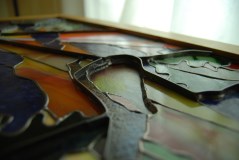 Then all pieces are foiled with black back foil and all pieces are soldered together.
On this panel there were hand-painted pieces that were being processed while I was soldering the piece together, so I just left the panel with bird-shaped holes.
Also I was plating the water sections so those were processed as separate pieces as well.
Then all pieces are foiled with black back foil and all pieces are soldered together.
On this panel there were hand-painted pieces that were being processed while I was soldering the piece together, so I just left the panel with bird-shaped holes.
Also I was plating the water sections so those were processed as separate pieces as well.Once the basic panel was put together, I mapped out the areas where I wanted extra reinforcing in the form of "structural fins." On this panel I used 1/4" x 1/32" brass strips. I pre-tin the brass strips, then solder in place while bending to conform to the lines. I create a spider web effect on select lead lines to help make the panel rigid and help prevent it from tearing itself apart over the years. Once these are in place I clean, and then patina select areas. Then I carefully solder on the plated areas all the way around to create sealed sections, careful not to use an excessive amount of solder and keeping everything very clean. After all plated sections are soldered in place, I can then solder the birds and apply the final patina. The final step is to create and attach my signature bugs. Then I can stand back and enjoy the panel before it's delivered!
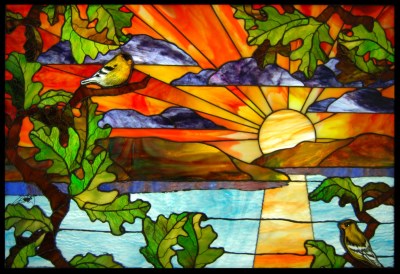
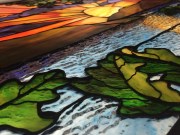
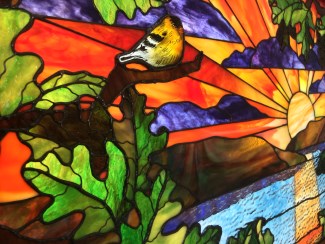
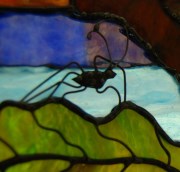
~ Craig Bacon
About the artist
Craig is from Madison, WI and was raised by artistic parents. He is a two-time graduate of Kendall College of Art and Design in Grand Rapids, MI with BFA's in Illustration and Furniture Design. He now works full-time as a furniture designer for a major furniture manufacturer. He has been running Craig Bacon Studio, participating in regional art fairs and executing custom commissions since 1994. His studio is located along the Mississippi River in Trempealeau, WI. He lives with his wife and six year old son and enjoys reading about architecture, design and technology, watching great movies and executing magnificent Lego creations with his son.
You can visit Craig's webpage and Facebook page, and you can follow him on Twitter (@cbaconstudio).
This pattern may be used to make one or more artworks for sale or personal enjoyment. This pattern may be printed for personal use only and may not be sold or given away in printed or electronic form.
Each month we feature a project designed using Glass Eye 2000. Do you have a project to share with the world? Contact Dragonfly Software and your creation might be our next Design of the Month.